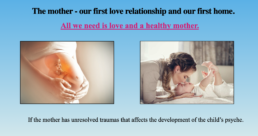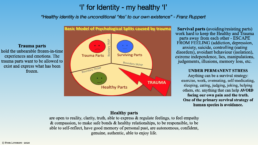” Everything you need to know for your own trauma healing is within you.
You can access it when you are ready to take the risk. “ Prof. Dr. Franz Ruppert – founder of IoPT
IoPT
Trauma therapy in a safe and gentle way
Identity-oriented Psychotrauma Therapy (IoPT) is an emerging psychological modality founded on the theories and practice developed by Professor Dr. Franz Ruppert over 30 years ago, and presented in his numerous books, lectures, presentations and interviews. IoPT offers an in-depth exploration of personal trauma and a specific understanding of trauma as a psychological SPLIT that results in emotional, physical, developmental and relational wounding in a human being. The practice of IoPT, the Intention Method also called the Self-encounter is a simple and effective tool to access and retrieve the lost parts of our identity and integrate them in a step by step process.
The IoPT framework provides a safe way to explore the suppressed and unconscious parts of the psyche, to recover from the effects of trauma and to restore our healthy self. The central focus in this therapy is on a personal life and an in-depth discovery of one’s own identity. IoPT invites us to explore the existential questions: WHO AM I? and WHAT DO I WANT? IoPT provides a specific perspective on identity, which is defined as everything that a person experienced from the moment of conception until the present. As Prof Ruppert explained: “Healthy identity is the unconditional ‘Yes’ to our own existence” and every Self-encounter process facilitates the expansion and growth of the healthy self which often cannot exist fully in a traumatised and traumatising family system and in the society.
“All we need to process is stored in our body and our psyche and appears in the IoPT session when we need it.”
Prof. Dr. Franz Ruppert – founder of IoPT

The Intention Method
The Intention Method, also called the Self-encounter Method developed by Prof Franz Ruppert is a safe and effective way of exploring one’s psyche in relation to a particular issue.
The Intention Method is a process that helps to identify the parts that have been disconnected from your true identity and which the core self wants to retrieve over and over again. The disconnection of the inner parts may be reflected in many survival strategies that are commonly seen in our society, such as: depression, addictions, anxiety, suicidal attempts, loneliness and other emotional and psychological symptoms as well as physical ailments that often may indicate at the origins in early trauma, such as insomnia, chronic fatigue, fibromyalgia, allergies and other autoimmune diseases.

What happens in a SELF-ENCOUNTER PROCESS ?
The Intention Method can be done, and it works in a very effective way equally in person and online, in a group and in a 1 to 1 session.
The first step is to formulate an intention which could be anything from a person’s life that feels unresolved, problematic or painful, it can be a sentence, a question, a dream or a drawing, simply anything that feels important to you, for example:
” Why I get sick? / Why I have allergy? / Why I suffer so much? ” / etc.
” I want to feel loved.”
” I want to have family / money / loving relationship, etc.”
“I want to be happy / healthy / wealthy / free from fear / shame.” etc.
“I want to heal/ know why / explore my headaches /pains in the chest / insomnia / anxiety / depression.” /etc.
When it is done in a group setting, the intention holder will invite some members of the group who they feel resonate with different elements of the intention. Once the process starts the intention holder is totally in charge of the direction of his/her own ‘self-encounter’ process with the guidance of the leading facilitator and will be invited to interact with their inner parts, to explore together with the parts all the feelings, emotions, sensations and various states that emerge in the process for each person. The self-encounter process may have many different effects, such as: new insights and understanding, emotional/physical release, feeling of connection, freedom and peace within. However it can also bring, especially at the beginning of doing this work, a lot of intensity and challenges, such as hopelessness, resistance, anger, confusion, which are very common as we start touching the fundamental truths of what happened to us, and for the frozen in time internal child parts that only want the mother’s love, the truth can feel like a loss of the entire world.
Therefore every process, step by step, allows to melt the illusions of the inner child, the walls that often hold beliefs and truths that don’t belong to the healthy, true self. Looking at my own example, in my childhood I often heard my mother saying that she always wanted to have children, however in my own first processes after I encountered the mother in my own psyche that was unresponsive and frozen I realised that the reality for me and my inner parts was different. I could see and realise process after process that the truth is that my mother wanted me for herself…, but not me for myself… The processes showed me that in this early time of my life I was not truly wanted, my existence was not unconditionally welcomed, especially by my father who wanted a boy – this is one example of what we call relational trauma in IoPT work – my parts and myself after confronting such truth could slowly start relating and connecting with each other in a different way, as if after being lost they found a way home. Therefore self-encounter process often may feel like a process of birthing yourself and your own truth.

What means attachment in the human relationships?
Attachment – emotional bond with another person.
For a newborn baby safety, love and nurturing are essential and basic needs for survival and healthy development. The needs are provided by a primary caregiver, usually the mother, that becomes for a baby the primary attachment figure. If the needs of the newborn child are met in a healthy, loving and nurturing way that leads to the development of a secure attachment between mother and a baby that feels safe, protected and loved. However when there is a consistent or frequent disruption of safety and connection a baby needs to adapt to a challenging environment that the mother provides in the way how she responds or not to a baby.
What if there is a lack of healthy attachment?
The meaning, consequences and effects of attachment trauma and relational wounding for a human being:
- Attachment trauma is a consistent or frequent disruption of safety and connection (basic human needs)
- Attachment theory: Interactions with inconsistent, unreliable or insensitive attachment figures -> Disruption of the bonding process between a baby or child and the primary caregiver during the developmental years 0 – 5 years
- Bonding trauma – Emotional bond with a perpetrator – when caregivers are source of threat, terror, love and connection at the same time – (Stockholm Syndrome)
- Shock & betrayal – relational trauma “is an issue of power, where one person (the perpetrator) holds all the power and the other (the victim) none” V. Broughton
- Severe impact on a child’s physical, emotional, psychological and social growth – Child’s basic needs for safety, love and protection are on halt
- Disruptive attachment process interferes with the development of a secure, stable mental foundation; the brain, nervous system, organs (adulthood -> asthma, immune system, chronic fatigue, etc)
- Trauma in relationships is about what happened and also what did not happen: lack of secure attachment, safety, connection, attunement > nurturing, love (inappropriate/lack of touch, eye contact, verbal communication, stressful environment, absence of a healthy adult)
- An accumulation of various wounds that occurred between a primary care giver and a child in the early stages of life
- Increased emotional dysregulation -> Child learns from an adult how to regulate emotions – Experiencing frequent overwhelm in current relationships, extreme sensitivity & reactivity
- Reduced resilience in dealing with stressful life events – predisposition to break down psychologically in times of crisis
- Coping strategies in adulthood that create more problems and conflicts than solutions in the relationships with other people -> Inability to manage and repair minor miscommunications or misunderstandings in relationships
- Intense feelings of being rejected and abandoned (matter of life and death) present in adult relationships (emotional starvation/deprivation)
- Reenactment – unconsciously recreating familiar situations that evoke feelings from the original trauma, eg. terror, powerlessness, stuckness, rage, victim-perpetrator roles, etc.
Basic model of psychological split caused by trauma developed by Prof Franz Ruppert
